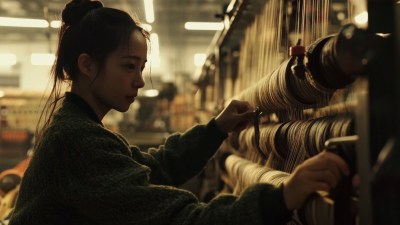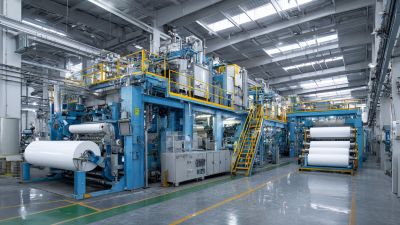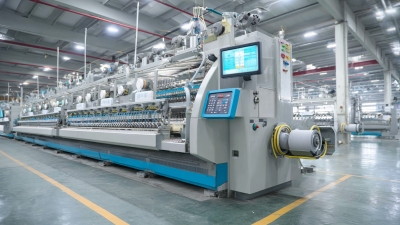Leave Your Message
In 2023, the textile industry is witnessing a significant transformation, primarily driven by the advent of the Automatic Textile Machine. This innovative technology not only enhances production capabilities but also improves operational efficiency by an impressive 30%. As manufacturers face increasing demands for faster turnaround times and higher quality outputs, these machines stand out as a pivotal solution. This article delves into how automatic textile machines revolutionize fabric production processes, detailing their advanced functionalities and the substantial benefits they offer. From reducing labor costs to minimizing human error, the integration of automatic systems redefines traditional practices. By exploring the various ways to implement these machines effectively, we aim to provide insights into optimizing production workflows in the textile sector. Join us as we investigate the future of fabric manufacturing in light of this groundbreaking technological advancement.

The role of automatic textile machines in modern fabric production is pivotal as industries adapt to new technologies and consumer demands. In 2023, advancements in automation have shown to boost production efficiency by an impressive 30%. This surge is not merely a number; it reflects a fundamental shift in how textiles are manufactured, emphasizing speed, precision, and sustainability. Spinning, weaving, knitting, and finishing machines are all leveraging automation to streamline operations, reduce labor costs, and enhance product quality.
**Tips:** When considering the implementation of automatic textile machines, assess your current production workflow to identify bottlenecks. Investing in innovative machines not only improves efficiency but also positions your business ahead of competitors in an increasingly digital marketplace.
Moreover, innovations in knitting technology have transformed this sector, which is vital to the textile and garment industry. Enhanced knitting technologies incorporate automation to facilitate quick adjustments and integrate sustainable practices. Reports indicate that companies utilizing these advancements report a significant rise in output and a reduction in waste.
**Tips:** Look for machines that offer adaptive technology, enabling you to switch between multiple product lines with minimal downtime, thus maximizing your operational flexibility and responsiveness to market trends.
| Dimension | Value |
|---|---|
| Production Time Reduction | Up to 30% |
| Labor Cost Savings | 25% |
| Defect Rate | Decreased by 15% |
| Energy Consumption | Reduced by 20% |
| Production Capacity Increase | Up to 40% |
| Maintenance Downtime | Reduced by 50% |
| Return on Investment (ROI) | Achievable in 18 months |
In 2023, advancements in automatic textile machines have significantly transformed the efficiency of fabric production, with reports indicating a boost of up to 30%. This increase can be attributed to the integration of key technologies within the textile manufacturing sector. For instance, the adoption of smart automation and artificial intelligence has optimized processes, enabling manufacturers to streamline operations and reduce production costs. A recent survey estimates that the implementation of these cutting-edge technologies could yield a productivity increase of nearly 25% across various textile production lines.
Moreover, the industry has seen significant innovations, particularly in the realm of fiber production. Research institutions have successfully utilized genetic engineering to develop silk-producing silkworms, while advances in carbon fiber technology have led to applications in high-demand areas such as drones and wind energy. According to the National Bureau of Statistics, recent figures indicate that chemical fibers remain the predominant raw materials in China's textile industry, marking a substantial growth trajectory fueled by digital transformation initiatives. These developments underscore the resilience and adaptability of the textile sector as it evolves to meet global market demands.
The textile industry has witnessed remarkable transformations in recent years, primarily driven by automation. A comparative analysis of traditional and automated fabric production reveals significant disparities in efficiency and output quality. Traditional methods often rely heavily on manual labor, which can introduce inconsistencies and slow down production timelines. In contrast, automated textile machines streamline the process, enhancing speed and reducing the potential for human error. This shift allows manufacturers to meet the increasing market demand without compromising quality.
Automated systems not only boost efficiency by an impressive 30% but also facilitate real-time monitoring and adjustments during production. These machines utilize advanced technologies, such as AI and IoT, to optimize operations, leading to better resource management and waste reduction. The initial investment in automation may be substantial, but the long-term benefits—including lower operational costs and the ability to scale production quickly—make it a worthwhile endeavor for many textile producers. As the industry continues to evolve, the gap between traditional and automated production methods is likely to widen, paving the way for a more efficient and sustainable future in fabric manufacturing.
The integration of automatic textile machines in fabric production has proven to significantly enhance operational efficiency, leading to noteworthy cost savings for manufacturers. By utilizing advanced automation technologies, textile operations can reduce labor costs, minimize waste, and expedite production cycles. This shift not only helps in meeting rising consumer demands but also enables manufacturers to allocate resources more effectively, thus optimizing their overall financial performance.

Economic impact goes beyond immediate cost reductions; the enhanced efficiency also translates into greater competitiveness within the market. Companies can lower their price points while maintaining profit margins, allowing them to capture larger market shares. Furthermore, as manufacturers embrace these innovations, they contribute to a more sustainable textile industry, reducing environmental costs associated with overproduction and resource depletion. Ultimately, the advancements in textile machinery are reshaping the economy of fabric production, driving growth and sustainability in 2023 and beyond.
The landscape of fabric production is rapidly transforming, driven by advancements in textile automation and a growing emphasis on sustainable practices. As manufacturers embrace automatic textile machines, efficiency has surged by 30% in 2023, allowing for faster production cycles and reduced operational costs. This shift not only enhances profitability but also paves the way for eco-friendly practices that align with consumer demands for sustainability.
To effectively integrate these advancements, companies should consider adopting materials that are biodegradable or recycled, thereby reducing waste during both the production and post-consumer phases. Additionally, investing in technologies that monitor energy consumption can significantly lower carbon footprints.
Tips:
1. Explore partnerships with eco-conscious suppliers to source sustainable textiles.
2. Implement energy-efficient machinery to complement your automated processes.
3. Regularly assess production methods for potential areas of waste reduction and sustainability enhancements.
As textile automation gains traction, the industry stands at a crucial juncture where innovation and sustainability can coexist, translating to long-term benefits for both businesses and the environment.







